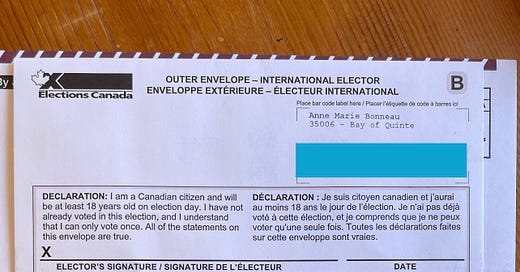If you’d like to read previous newsletters, go here.
The short version of today’s newsletter: Take two minutes to register to vote. In the US, go to vote.gov. In Canada, go here. (I’m sorry but today’s newsletter is especially US- and, to a lesser degree, Canada-centric. If you live outside the US and Canada, I hope you still find it helpful.)
The economic system in which we operate drives our individual emissions
According to this study, household energy use accounts for 20 percent of greenhouse gas emissions in the US. Reducing our carbon footprints matters but how much control do we have over that 20 percent figure?
When I turn on my laptop to write this newsletter, for example, I consume electricity and generate greenhouse gas emissions but my utility (mostly) controls the source of my energy. Now let’s say my power comes from coal (it doesn’t but we’ll stick with coal for now) and let’s also pretend I really don’t care (also not true). Policies that switch my city or state’s energy sources from fossil fuels to renewables will reduce my household emissions (and my neighbors’ emissions) whether I want them to go down or not.
While important, individual changes can reduce emissions only so much. First, we individuals have to care. Then we have to take time to research solutions, make a plan to implement the solutions and then, especially if we want to electrify our homes, spend some money—and have that money to spend!
This is a long way of saying we need to elect politicians at every level—federal, state and local—who will implement policies that will bring about sweeping changes. And a first step to electing leaders who take the crisis seriously is registering to vote.
Millions of environmentalists in the US don’t vote
Before the 2020 US election, the Environmental Voter Project (EVP) estimated that 11 million environmentalists in the US were unlikely to vote, with even higher numbers sitting out of state and local elections. Politicians prioritize the issues that get them elected. If people who care about the environment don’t vote, politicians ignore them—and climate change.
EVP has been successfully turning out these non-voters. The organization identifies environmentalists who don’t vote and, through texting, calling, mailing and canvassing, persuades them to vote. EVP doesn’t try to change minds on the climate crisis; that requires more effort and money than encouraging people who already care about it to vote.
Since it began in the fall of 2015, EVP has contacted 7.4 million non-voting or seldom-voting environmentalists, 730,000 of whom now consistently vote for the environment in every federal, state, and local election.
A small number of environmental voters can swing elections. And in municipal elections, their turnout can make an even bigger impact, thus affecting local policy on mass transit, building standards and bike and pedestrian infrastructure, for example.
After you have registered to vote, if you’d like to encourage non-voting or seldom voting environmentalists to register, you can get involved with EVP here.
Action of the day: Register to vote
Or update your voter information. Click the buttons below to get started.
How did it go? Were you able to register to vote (or to update your voter information)? Please let us know.





This is brilliant! Makes the connection between the environmental and the political.
This is great! Thank you!! I'm a regular voter and a poll manager, but I live in a generally climate change-denying area, so the link to get involved with the EVP is super helpful-- and encouraging.